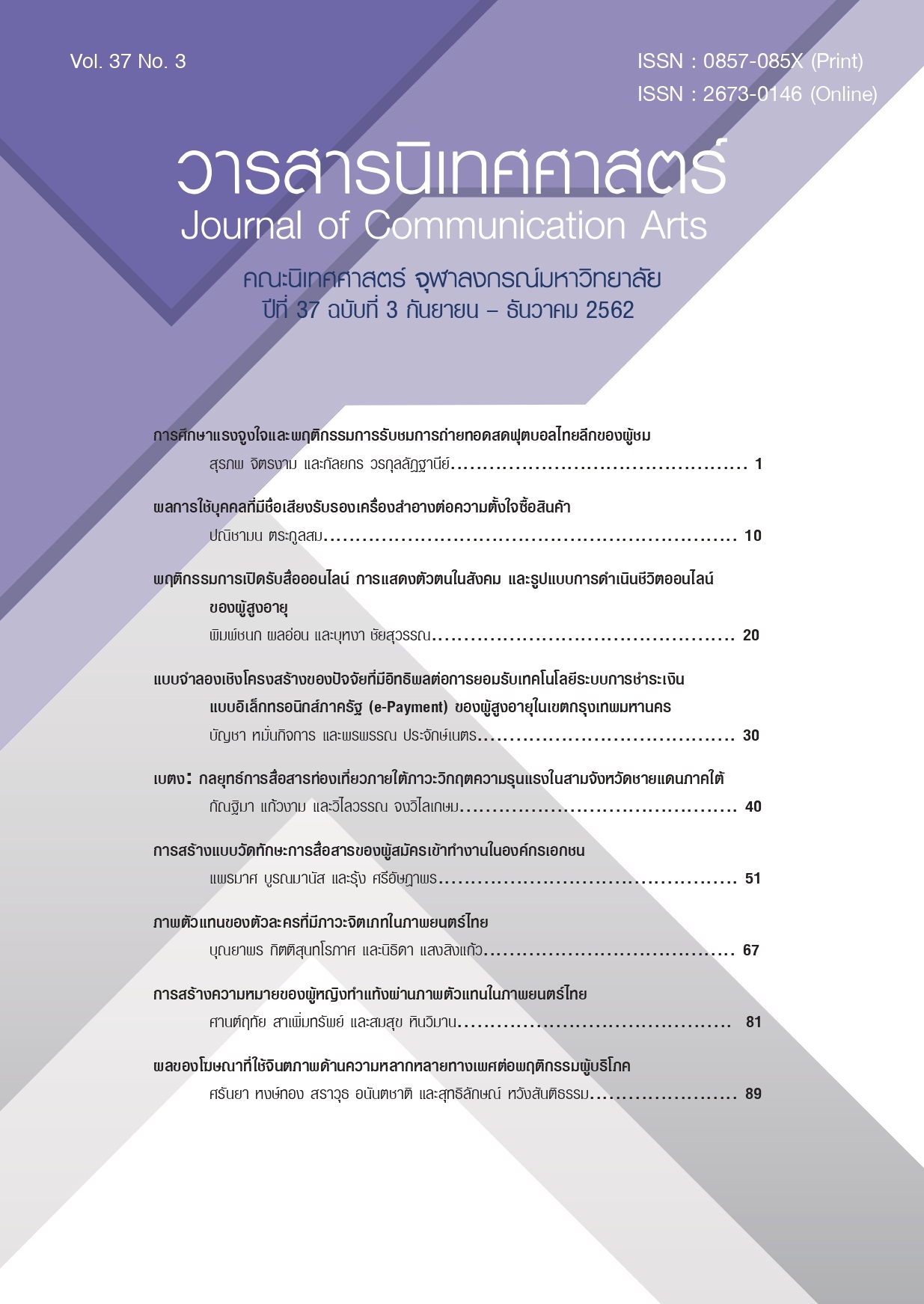Online Media Exposure Behavior, Social Presence and Online Lifestyle of the Elderly
Main Article Content
Abstract
The aims of this research were 1) To study the behavior of online media exposure behavior, social presence of the elderly and online lifestyle of the elderly. 2) to examine the relationship between online media exposure behavior and social presence of the elderly, and 3) to examine the relationship between social presence and the online lifestyle of the elderly. The study employed mixed methods. The group interviews were used in qualitative research, the sampling were 5 elderly, aged between 50-65 years. The Quantitative research was conducted by using an online questionnaire, the sampling were distributed to 200 50-65 year old seniors via online media. Additionally, the purposive samples and snowball sampling were conducted to select the sample and the data was tabulated by Pearson Product Moment Correlation. As a result, the findings are as follows: The research found that the sample has Online media exposure behavior the highest exposure to LINE. The result is an online lifestyle as well as typing. Join the group and Online media exposure behavior In order to receive timely information. Include search information. That is not in the old media. As a result, the online lifestyle, including keeping up with the latest news. And interest in learning new things. The elderly have the opinion that. People should be self-reliant. Success in life is to have a warm family and no one is too old, and online communication has the ability to communicate in a communicative way that can convey the emotions that stimulate social identity. Effectively communicates quickly, effectively, and effectively. Media Exposure Behavior Social identity And the online lifestyle is very similar.
Article Details
References
ชัชวาลย์ หลิวเจริญ. (2559). การใช้ “โซเชี่ยล แมสเสจจิง” ในการสื่อสารเพื่อสร้างความร่วมมือและจัดการความขัดแย้งระหว่างบุคคลในองค์กร. วารสารนักบริหาร, 36(1), 79 – 87.
ชนัญญา เภกะนันทน์. (2556). รูปแบบการดำเนินชีวิต การเปิดรับสื่อ และการยอมรับนวัตกรรมของผู้บริโภค(วิทยานิพนธ์ปริญญามหาบัณฑิต). จุฬาลงกรณ์มหาวิทยาลัย.
บุหงา ชัยสุวรรณ. (2561). ที่ศึกษาการจัดกลุ่มและหาคุณลักษณะของกลุ่มดิจิทัลอิมมิแกรนท์ตามพฤติกรรมการสื่อสารในบริบทออนไลน์ และปัญหาทางความสัมพันธ์กับสังคม. วิทยานิพนธ์ปริญญามหาบัณฑิต. สถาบันพัฒนบริหารศาสตร์.
ภาสกร จิตรใคร่ครวญ. (2553). เทคโนโลยีของสื่อใหม่และการนำเสนอตัวตนต่อสังคมกับพฤติกรรมการสื่อสารบนเครือข่ายสังคมออนไลน์. วิทยานิพนธ์ปริญญามหาบัณฑิต. จุฬาลงกรณ์มหาวิทยาลัย, กรุงเทพฯ.
มูลนิธิสถาบันวิจัยและพัฒนาผู้สูงอายุไทย. (2559). สถานการณ์ผู้สูงอายุไทย พ.ศ.2559. กรุงเทพฯ: มูลนิธิสถาบันวิจัยและพัฒนาผู้สูงอายุไทย.
เลิศหญิง หิรัญโญ. (2545). รูปแบบการดำเนินชีวิต พฤติกรรมการเปิดรับสื่อ และพฤติกรรมการบริโภคสินค้าของผู้สูงอายุ.วิทยานิพนธ์ปริญญามหาบัณฑิต. จุฬาลงกรณ์มหาวิทยาลัย.
เล็ก สมบัติ และคณะ. (2554). ภาวะสูงวัยอย่างมีคุณประโยชน์ กับการพัฒนาสังคม และเศรษฐกิจในประเทศไทย. รายงานวิจัยฉบับสมบูรณ์เสนอสำนักมาตรฐานการ พัฒนาสังคม และความมั่นคงของมนุษย์สำนักงาน ปลัดกระทรวงการพัฒนาสังคม และความมั่นคงของมนุษย์.
วิศปัตย์ ชัยช่วย. (2560). การใช้LINEของผู้สูงอายุ: การศึกษาเชิงปรากฏการณ์วิทยา. วิทยานิพนธ์ปริญญามหาบัณฑิต. มหาวิทยาลัยศิลปากร.
สำนักงานสถิติแห่งชาติ. (2560). ข้อมูลสถิติจำนวนผู้สูงอายุประเทศไทย ปี 2559. วันที่เข้าถึงข้อมูล 7 มีนาคม 2561, แหล่งที่มา https://www.dop.go.th/th/know/1/51
อารีย์ มยังพงษ์ และเกื้อกูล ตาเย็น. (2559). ปัจจัยที่ส่งผลต่อความต้องการเรียนรู้สื่อเทคโนโลยีของผู้สูงอายุในยุคหลอมรวมเทคโนโลยี. กรุงเทพมหานคร: มหาวิทยาลัยเทคโนโลยีราชมงคลพระนคร.
อุษา กิตติพันธ์โสภณ. (2557). อิทธิพลของการรับรู้ตัวตนบนเครือข่ายสังคมที่มีผลต่อความตั้งใจ ซื้อสินค้าบนเครือข่ายสังคมออนไลน์. วิทยานิพนธ์ปริญญามหาบัณฑิต. มหาวิทยาลัยธรรมศาสตร์.
Brandinside. (2559). วิเคราะห์การใช้อินเทอร์เน็ตของคนไทย 2559 เรื่องที่แบรนด์ต่างๆ ต้องรู้. วันที่เข้าถึงข้อมูล 7 มีนาคม 2561, แหล่งที่มา https://brandinside.asia/survey-internet-thailand-user-2559
ภาษาอังกฤษ
Betsy Baugess. (2015). Examining Social Network Site Usage by Older Adults: A Phenomenological Approach. Nova Southeastern University, New York.
Biocca, et al. (2001). The Networked Minds Measure of Social Presence: Pilot Test of the Factor Structure and Concurrent Validity. Michigan State University, New York.
Cheung, C. M., Chiu, P. Y., & Lee, M. K., (2011). Online social networks: Why do students use facebook. Hong kong Baptist University. Hongkong.
Cowgill. (1974) Aging and Modernization. Appleton-Century-Crofts, New York.
Gunawardena, C. N. (1995). Social Presence Theory and lmplications for Interaction and Collaborative Leaning in Computer Conferences. International Journal of Educational Telecommunications, 1(2), 147-166. Charlottesville, VA: Association for the Advancement of Computing in Education (AACE).
Moen, P., Dempster - McClain, D., & Williams, R. W., Jr. (1992). Successful aging: A life course perspective on women’s multiple roles and health. American Journal of Sociology, 97, 1612-1638.


